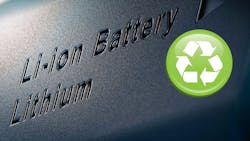National Lab and NEMA Team up to Create Recycling Standards for Lithium-Ion Batteries
Recycling standards would make it easier for companies developing lithium-ion batteries to meet possible future environmental standards, increasing the odds of economic success for future battery recycling efforts.
Argonne and the National Electrical Manufacturers Association (NEMA) have signed a memorandum of understanding on developing recycling standards for recycling standards for lithium-ion batteries based on their design.
Today no such standards exist, despite the rapid growth of lithium-ion batteries worldwide and the emergence of a wide range of recycling methods. In the meantime , battery manufacturers have focused primarily on making batteries cheaper and more efficiently. But industry experts say it’s time to force battery makers to consider what happens to batteries at the end of their life.
“If we don’t innovate to address end-of-life challenges and consider environmental impacts as more and more batteries are being produced, we’re going to have a big problem 10 years from now,” says Jonathan Stewart, industry director of NEMA’s Utility Products and Systems division.
Variations in battery designs, materials, and chemistries, as well as recycling methods, all affect recyclability. This makes it extremely difficult to establish a common set of standards. Argonne scientists and NEMA experts will explore these complexities under the memorandum with the goal of identifying and crafting standards that manufacturers and recyclers can use to assess how much recyclable materials get used in various battery designs.
“Standards can give recyclers a baseline for how much material and, in turn, how much revenue they can expect to recover from a battery. They can also help manufacturers understand what materials and designs are likely to be more recyclable, which can inform their R&D,” says Jeff Spangenberger, the Materials Recycling R&D group lead at Argonne and director of the ReCell Center, a battery recycling R&D center led by Argonne and funded by the Department of Energy (DoE).
Developing a standard will require the participation of many stakeholders. Argonne will try to involve many of the organizations already working on this, such as the those at ReCell Center.
